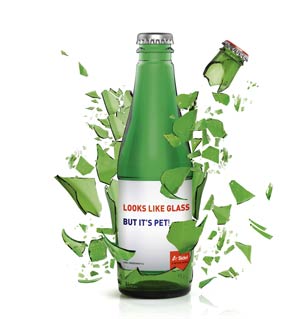SIDEL
PET bottle for beer now available / Proprietary gas-barrier technology helps achieve 6-month shelf life
 A crown cap and a non-petaloid base make the PET beer bottle appear to look like glass (Photo: Sidel) |
Weighing just 28 grams and utilising a champagne base, liquid packaging and equipment supplier Sidel (Hünenberg / Switzerland; www.sidel.com) has launched a new beer bottle that looks like glass but has all the benefits of PET. Claiming it has developed the first PET container for beer on the market which can be pasteurised, Sidel says the innovation is the logical step for a liquid waiting to join a long line of other food and beverage products that have made the switch to PET due to safety, weight, design flexibility and recyclability aspects associated with PET packaging solutions.
“Increasingly, consumers are becoming more aware of the benefits of PET because they experience it as the preferred packaging material in other food and beverage areas in their life. So, to help producers and consumers alike make the transition, we wanted a bottle that looked like glass, but has all the benefits of PET,” explains Christophe Bunel, head of packaging care for the Swiss company.
To make its point, Sidel has blown a 330-ml version, which, it says, has a 6-month shelf life with less than one part-per-million (ppm) of oxygen ingress along with under 17% carbon dioxide loss. It can also provide bottles up to 600 ml and in fact is already developing even larger sizes. With its proprietary “Actis” gas-barrier technology and single-layer material blends, Sidel says it is able to avoid two crucial factors in packaging beer – the prevention of oxygen from entering and carbon dioxide from escaping the container.
A major perception Sidel had to consider in developing the packaging solution was the notion that beer gets warmer more quickly when it is in a PET container. The company ran studies and determined that beer remained as cold in PET as it does in equivalent-sized glass bottles, with much less wall thickness and hence much less material weight. Sidel also had to ensure that its future product would not diminish the taste of the beverage, another misperception held by consumers who believe beer tastes better in cans.
The bottle can be used for flash or tunnel pasteurised beer as well as for micro-filtrated beer. Generally, tunnel-pasteurised beer requires a petaloid base; however, Sidel explains that due to a unique base and other design technologies the bottle is resistant to the pressures produced by prolonged high temperatures during the production process, yet still retains the appearance of a more traditional glass bottle. It can withstand pressures of 20 pasteurisation units (PU) in the tunnel, which is standard for lagers yet manages to retain a stable base after pasteurisation. In addition, the bottle design can be used on existing tunnel pasteurisers that currently serve glass bottles.
The word out of Hunenberg is that the company is currently in discussions with some of the world's leading beer producers to determine how best to bring the benefits of PET to beer using the new bottle design and packaging technology.
“Increasingly, consumers are becoming more aware of the benefits of PET because they experience it as the preferred packaging material in other food and beverage areas in their life. So, to help producers and consumers alike make the transition, we wanted a bottle that looked like glass, but has all the benefits of PET,” explains Christophe Bunel, head of packaging care for the Swiss company.
To make its point, Sidel has blown a 330-ml version, which, it says, has a 6-month shelf life with less than one part-per-million (ppm) of oxygen ingress along with under 17% carbon dioxide loss. It can also provide bottles up to 600 ml and in fact is already developing even larger sizes. With its proprietary “Actis” gas-barrier technology and single-layer material blends, Sidel says it is able to avoid two crucial factors in packaging beer – the prevention of oxygen from entering and carbon dioxide from escaping the container.
A major perception Sidel had to consider in developing the packaging solution was the notion that beer gets warmer more quickly when it is in a PET container. The company ran studies and determined that beer remained as cold in PET as it does in equivalent-sized glass bottles, with much less wall thickness and hence much less material weight. Sidel also had to ensure that its future product would not diminish the taste of the beverage, another misperception held by consumers who believe beer tastes better in cans.
The bottle can be used for flash or tunnel pasteurised beer as well as for micro-filtrated beer. Generally, tunnel-pasteurised beer requires a petaloid base; however, Sidel explains that due to a unique base and other design technologies the bottle is resistant to the pressures produced by prolonged high temperatures during the production process, yet still retains the appearance of a more traditional glass bottle. It can withstand pressures of 20 pasteurisation units (PU) in the tunnel, which is standard for lagers yet manages to retain a stable base after pasteurisation. In addition, the bottle design can be used on existing tunnel pasteurisers that currently serve glass bottles.
The word out of Hunenberg is that the company is currently in discussions with some of the world's leading beer producers to determine how best to bring the benefits of PET to beer using the new bottle design and packaging technology.
16.07.2014 Plasteurope.com [228625-0]
Published on 16.07.2014

 German version of this article...
German version of this article...